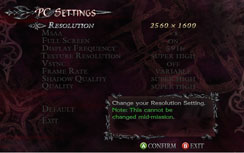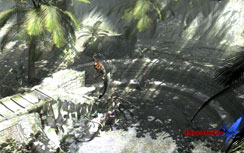Zotac GeForce GTX 260 AMP²! (216) Edition
Written by Tim Smalley
October 22, 2008 | 08:24
Tags: #216 #260 #article #card #consumption #cores #edition #evaluation #geforce #gtx #overclocking #performance #power #processors #review #stream

Devil May Cry 4
Publisher: CapcomDevil May Cry 4 had a relatively quiet introduction to the PC back in February this year, bringing ludicrous demon hack and slashery to the graphical splendour that is DirectX 10. You play as Nero, a member of the Order of the Sword whose job it is to smash, slash and explode as many bizarre looking demons and beasties in the most stylish possible manner. There's a lot more plot in the full game, but damned if we understood much of it.
Devil May Cry 4 (or DMC4 for short) is part of Nvidia's "The Way It's Meant To Be Played" program, and received a significant graphic refit for its PC release. Featuring full Direct X10 support, and with dozens of enemies on screen, the game is surprisingly graphically intensive even when run on the most modern hardware.
We used the game's inbuilt benchmark suite, and have taken our scores from the second test, which is the most graphically intensive. Because DMC4's benchmarks are AI driven, and so subtly different each time they are run, we ran the benchmark three times and have taken an average score for test two as the results below. We tested at 1,680 x 1,050 with 8xAA, 1,920 x 1,200 with 4xAA and 8xAA and at 2,560 x 1,600 with both 4xAA and 8xAA.
Because DMC4 does not support anisotropic filtering as standard, this was forced to 16xAF in the graphics driver control panel.
Devil May Cry 4
1680x1050 8xAA 16xAF, DX10, Maximum Detail
- ATI Radeon HD 4870 X2
- ATI Radeon HD 4870 1GB
- ATI Radeon HD 4870 512MB
- Nvidia GeForce GTX 280
- ATI Radeon HD 3870 X2
- BFG Tech GeForce GTX 260 OCX Maxcore
- Zotac GeForce GTX 260 AMP²!
- Zotac GeForce GTX 260 AMP!
- ATI Radeon HD 4850
- Nvidia GeForce GTX 260+
- Nvidia GeForce GTX 260
- Nvidia GeForce 9800 GTX+
- Nvidia GeForce 8800 GT
-
-
141.2
-
-
-
80.2
-
-
-
69.8
-
-
-
66.6
-
-
-
65.9
-
-
-
64.4
-
-
-
64.0
-
-
-
63.4
-
-
-
60.3
-
-
-
59.7
-
-
-
58.3
-
-
-
50.2
-
-
-
37.5
-
0
25
50
75
100
125
150
Frames Per Second
-
Average
Devil May Cry 4
1920x1200 4xAA 16xAF, DX10, Maximum Detail
- ATI Radeon HD 4870 X2
- ATI Radeon HD 4870 1GB
- ATI Radeon HD 4870 512MB
- ATI Radeon HD 3870 X2
- Nvidia GeForce GTX 280
- BFG Tech GeForce GTX 260 OCX Maxcore
- Zotac GeForce GTX 260 AMP²!
- Zotac GeForce GTX 260 AMP!
- ATI Radeon HD 4850
- Nvidia GeForce GTX 260+
- Nvidia GeForce GTX 260
- Nvidia GeForce 9800 GTX+
- Nvidia GeForce 8800 GT
-
-
143.3
-
-
-
80.8
-
-
-
71.7
-
-
-
68.2
-
-
-
65.8
-
-
-
62.6
-
-
-
62.2
-
-
-
62.0
-
-
-
60.6
-
-
-
54.5
-
-
-
51.3
-
-
-
41.7
-
-
-
32.1
-
0
25
50
75
100
125
150
Frames Per Second
-
Average
Devil May Cry 4
1920x1200 8xAA 16xAF, DX10, Maximum Detail
- ATI Radeon HD 4870 X2
- ATI Radeon HD 4870 1GB
- ATI Radeon HD 4870 512MB
- ATI Radeon HD 3870 X2
- ATI Radeon HD 4850
- Nvidia GeForce GTX 280
- BFG Tech GeForce GTX 260 OCX Maxcore
- Zotac GeForce GTX 260 AMP²!
- Nvidia GeForce GTX 260+
- Zotac GeForce GTX 260 AMP!
- Nvidia GeForce GTX 260
- Nvidia GeForce 9800 GTX+
- Nvidia GeForce 8800 GT
-
-
134.8
-
-
-
76.1
-
-
-
67.6
-
-
-
62.6
-
-
-
56.6
-
-
-
54.3
-
-
-
51.6
-
-
-
51.5
-
-
-
48.5
-
-
-
48.5
-
-
-
44.7
-
-
-
35.0
-
-
-
31.0
-
0
25
50
75
100
125
150
Frames Per Second
-
Average
Devil May Cry 4
2560x1600 4xAA 16xAF, DX10, Maximum Detail
- ATI Radeon HD 4870 X2
- ATI Radeon HD 4870 1GB
- ATI Radeon HD 4870 512MB
- ATI Radeon HD 3870 X2
- ATI Radeon HD 4850
- Nvidia GeForce GTX 280
- BFG Tech GeForce GTX 260 OCX Maxcore
- Zotac GeForce GTX 260 AMP²!
- Zotac GeForce GTX 260 AMP!
- Nvidia GeForce GTX 260+
- Nvidia GeForce GTX 260
- Nvidia GeForce 9800 GTX+
- Nvidia GeForce 8800 GT
-
-
96.3
-
-
-
55.4
-
-
-
48.9
-
-
-
43.7
-
-
-
40.0
-
-
-
38.0
-
-
-
36.4
-
-
-
35.2
-
-
-
34.8
-
-
-
31.7
-
-
-
30.8
-
-
-
21.9
-
-
-
17.5
-
0
25
50
75
100
Frames Per Second
-
Average
Devil May Cry 4
2560x1600 8xAA 16xAF, DX10, Maximum Detail
- ATI Radeon HD 4870 X2
- ATI Radeon HD 4870 1GB
- ATI Radeon HD 4870 512MB
- ATI Radeon HD 3870 X2
- ATI Radeon HD 4850
- Nvidia GeForce GTX 280
- BFG Tech GeForce GTX 260 OCX Maxcore
- Zotac GeForce GTX 260 AMP²!
- Zotac GeForce GTX 260 AMP!
- Nvidia GeForce GTX 260+
- Nvidia GeForce GTX 260
- Nvidia GeForce 9800 GTX+
- Nvidia GeForce 8800 GT
-
-
87.9
-
-
-
49.2
-
-
-
44.1
-
-
-
38.0
-
-
-
33.5
-
-
-
29.1
-
-
-
28.4
-
-
-
27.2
-
-
-
26.3
-
-
-
24.7
-
-
-
24.2
-
-
-
15.8
-
-
-
13.5
-
0
10
20
30
40
50
60
70
80
90
Frames Per Second
-
Average
Despite being a part of Nvidia's The Way It's Meant To Be Played programme, this game ends up being faster on AMD hardware pretty much right across the board. We've only tested with anti-aliasing enabled, so there may be occasions where Nvidia is faster when AA is disabled, but the frame rates are generally high enough to leave at least 4xAA turned on. After all, you should be doing that on cards like these in this day and age.
Because of this, the Zotac GeForce GTX 260 AMP²! Edition doesn't really change the performance spectrum in this title - if you want the best performance with anti-aliasing enabled, you're best looking at the ATI Radeon HD 4870 1GB.











Want to comment? Please log in.